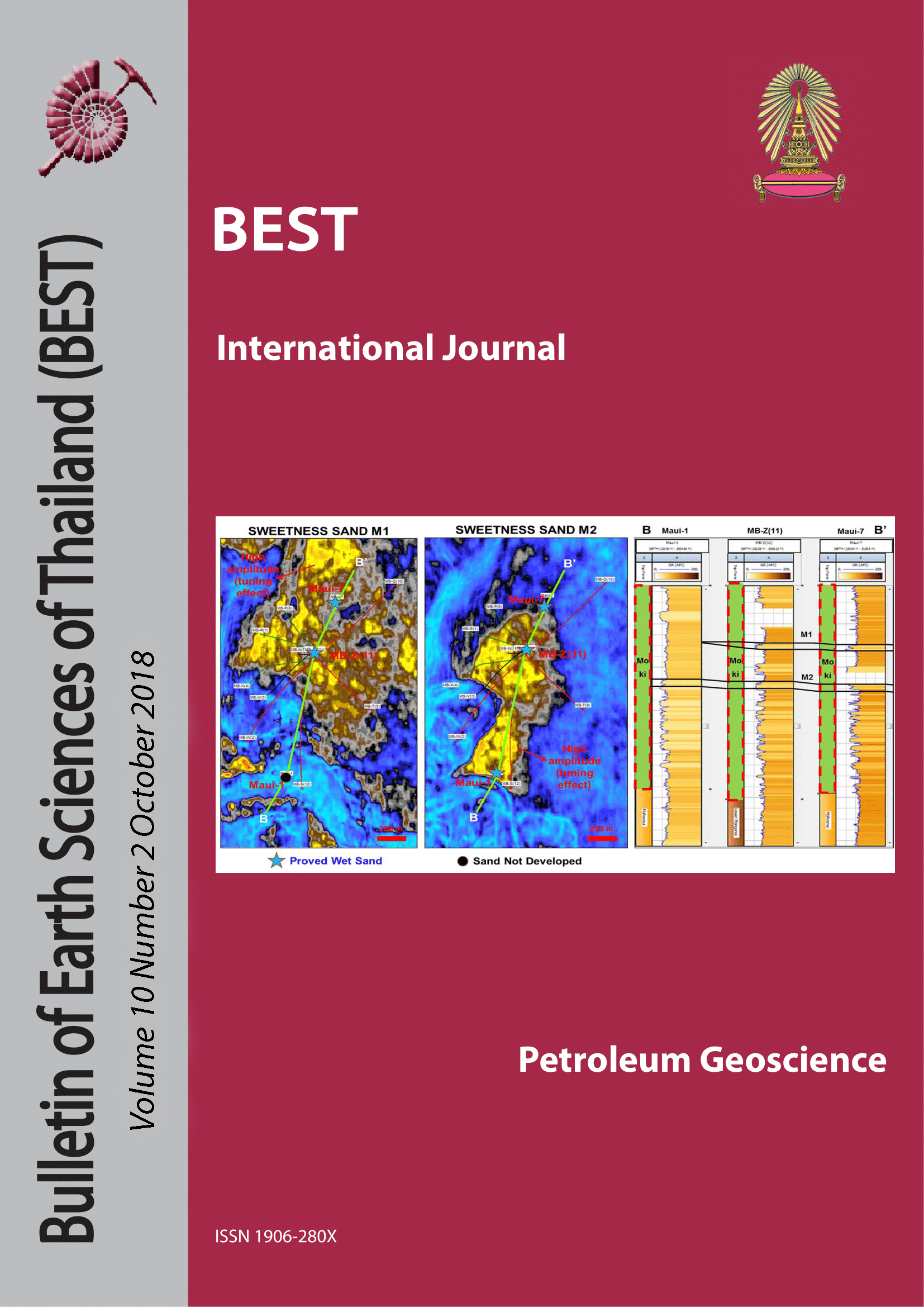Diagenesis and its impact on reservoir quality in a Triassic Sandstone, Berkine basin, North Africa
Main Article Content
Abstract
The TAGI reservoir was deposited in a Triassic braided fluvial system; it is widely distributed across the Berkine Basin of northern Africa. Reservoir quality across the basin is generally lower at depth due to compaction. However, production tests in the study area, which is located in the northern part of the Berkine Basin show that the TAGI in a deeper area has somewhat higher production rates in the lower part of the TAGI reservoir where it directly overlies the Hercynian Unconformity. This improvement in reservoir quality is thought to indicate a lack of compaction or some other diagenetic association. The mineral compositions, diagenetic components, intensities and sequences were analyzed using a combination of petrography, XRD, SEM, core porosity-permeability, well testing and conventional well log data. Much of the variation in production rates and reservoir quality is a result of the varying development of authigenic phases in the TAGI. The two most significant factors associated with improved reservoir quality at depth are the presence of chlorite rather than illite and dissolution porosity. That is, proportions of secondary dissolution pores and levels of grain-coating chlorite are more abundant in high flow wells, while illite, mixed-layer illite/smectite, anhydrite and carbonate cements are more abundant in low flow wells. The clay mineral types, chlorite versus illite, can be identified using spectral gamma ray cross plots. Much of the improvement in reservoir quality has occurred in the deeper burial realm where late-stage laterally-flowing highly-saline (dense) acidic basinal waters are being focused into the lower part of the TAGI sand. This is a region of pore-fluid cross-flow directly above the impervious fine-grained sediments that underlie the Hercynian Unconformity.
Article Details

This work is licensed under a Creative Commons Attribution-NonCommercial-NoDerivatives 4.0 International License.
Copyright © 2008 Department of Geology, Faculty of Science, Chulalongkorn University. Parts of an article can be photocopied or reproduced without prior written permission from the author(s), but due acknowledgments should be stated or cited accordingly.
References
Beaufront, D., Rigault, C., Billon, S., Billault, V., Inoue, A., Inoue, S. and Patrier, P., 2015. Chlorite and chloritization processes through mixed-layer mineral series in low temperature geological systems: Clay Minerals, v. 50, pp. 497-523.
Galeazzi, S., Point, O., Haddadi, N., Mather, J. and Druesne, D., 2012. The Illizi and Berkine Basins in Southern Algeria: Regional Geology and Tectonics, Phanerozoic Passive Margins, Cratonic Basins and Global Tectonic Maps, pp. 662-729.
Hedley, R., McKenna, S., Gauthier, F. and Mount, V., 2003. The Structural & Tectonic Evolution of the Saharan Platform in Algeria: AAPG Hedberg Conference.
Henares, S., Caracciolo, L., Cultrone, G., Fernández, J. and Viseras, C., 2013. The role of diagenesis and depositional facies on pore system evolution in a Triassic outcrop analogue (SE Spain): Marine and Petroleum Geology, v.51, pp. 136-151.
Henares, S., Caracciolo, L., Viseras, C., ern´andez, J. and Yeste, L. M., 2016. Diagenetic constraints on heterogeneous reservoir quality assessment, A Triassic outcrop analog of meandering fluvial reservoirs: AAPG Bulletin v. 100, pp. 1377-1398.
Klaja, J. and Dudek, L., 2016. Geological interpretation of spectral gamma ray (SGR) logging in selected boreholes: Oil and Gas Institute, National Research Institute Poland.
Moffat, I. and Johns, C., 2001. Petroleum Systems of the Berkine Basin: Rock the Foundation Convention, Canadian Society of Petroleum Geologists.
Morad, S. Ben Ismail, H. N., Fernando De Ros, L., Al-Aasm, I. and Serrhini, N. E., 1994. Diagenesis and formation water chemistry of Triassic reservoir sandstones from southern Tunisia: Sedimentology, v. 41, pp. 1253-1272.
Morad, S., Al-Ramadan, K., Ketzer, J. M., and De Ros, L. F., 2010. The impact of diagenesis on the heterogeneity of sandstone reservoirs, A review of the role of depositional fades and sequence stratigraphy: AAPG Bulletin, v. 94, pp. 1267-1309.
Rossi, C., Kälin, O., Arribas, J. and Tortosa, A., 2002. Diagenesis provenance and reservoir quality of Triassic TAGI sandstones from Ourhoud field, Berkine (Ghadames) Basin, Algeria: Marine and Petroleum Geology, v. 19-2, pp. 117-142.
Rukuni, T., Maree,J., Zvinowanda, C. and Carlsson, F., 2012. The Effect of Temperature and Pressure on the separation of Calcium Carbonate and Barium Sulphate from a Mixed Sludge: Journal of Chemical Engineering & Process Technology, v.3.
Theo Kloprogge, J., Komarneni, S. and Amonette, J., 1999. Synthesis of smectite clay minerals - A critical review: Clays and Clay Minerals, v. 47, pp. 529-554.
Turnera, P., Pillingb, D., Walkerb, D., Extonc, J., Binniec, J. and Sabaoua, N., 2001.Sequence stratigraphy and sedimentology of the late Triassic TAG-I (Blocks 401/402, Berkine Basin, Algeria): Marine and Petroleum Geology, v.18, pp. 959-981.
Warren, J., Morley, C. K., Charoentitirat, T., Cartwright, I., Ampaiwan, P., Khositchaisri, P., and Yingyuen, J., 2014. Structural and fluid evolution of Saraburi Group sedimentary carbonates, central Thailand: A tectonically driven fluid system. Marine and Petroleum Geology, v.55, pp.100-121.


